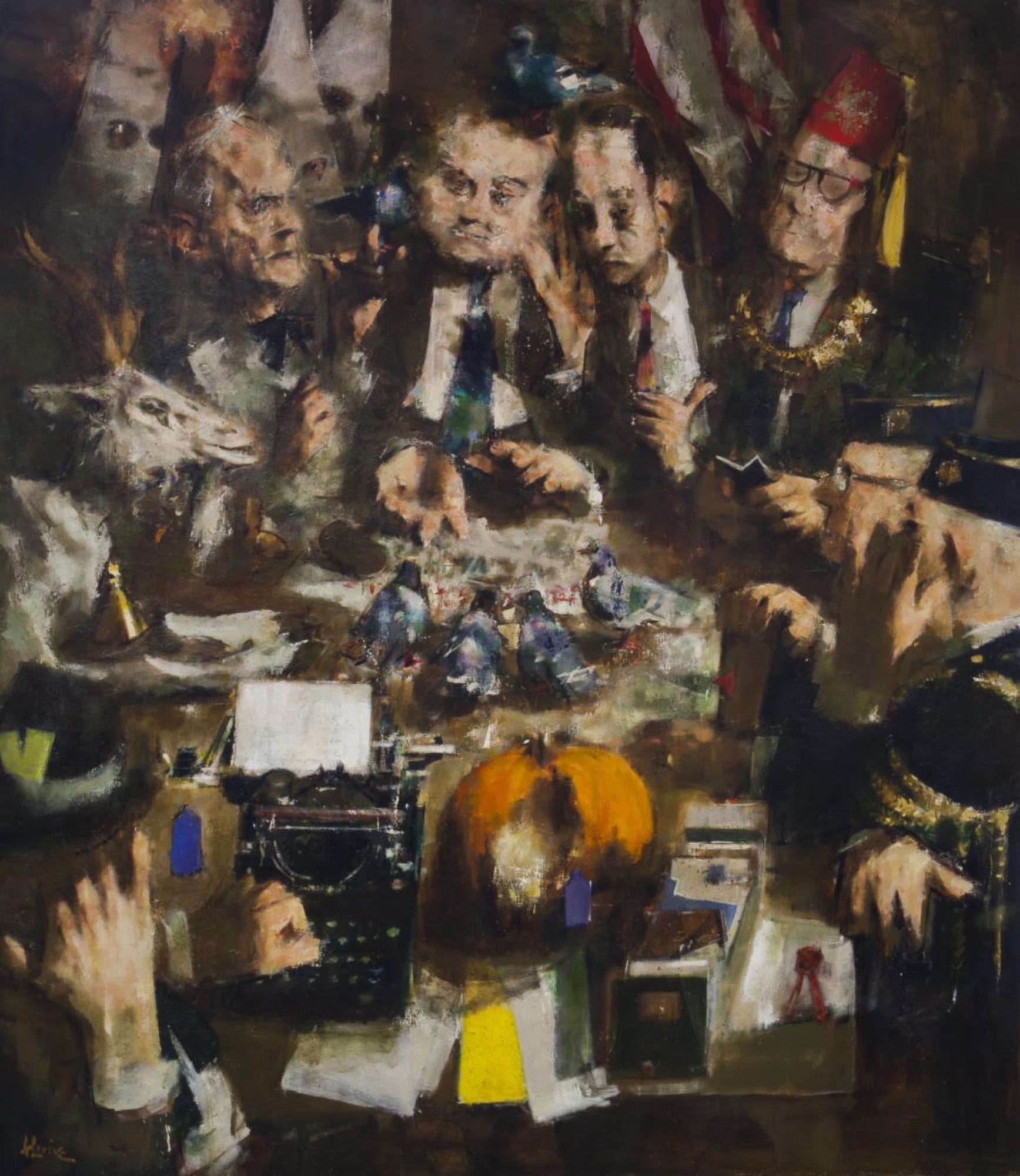Jack Levine
Jack Levine was a notable American Social Realist, whose satirical paintings were directed at the corruption and evils he observed in business, politics, and society. Levine was born to a large immigrant family in South Boston where he was accustomed to poverty and street life, themes that would later inform his work. At an early age, Levine studied art with Harold Zimmerman and Denman Ross, founder of Harvard University’s art department. These mentors encouraged Levine’s pursuit of art and instilled an appreciation for classical art history and technique. Levine’s earliest influences were old masters like Titian, Velásquez, and Goya, and German Expressionists like George Grosz and Oskar Kokoschka. Along with childhood friend Hyman Bloom, Levine was a cofounder of the Boston Expressionist movement in the early 1930s. The group painted social and spiritual themes in an expressive, figural style. Paintings by the group are characterized by emotional directness and dark humor. The representational movement flourished during the mid-century even as abstraction was the center of the art world.
In 1935, Levine was employed as an artist for the Works Progress Administration. Using a unique style of Social Realism and Expressionism, he painted works that expressed his moral outrage with the Depression era. In 1936, he exhibited two paintings (The Card Game and Brain Trust,) at the Museum of Modern Art. The following year, Levine painted The Feast of Pure Reason, a controversial painting that earned him wide recognition in the art world. The work depicted a police officer, a capitalist, and a politician gathered at a table, their portly bodies symbolic of their abuses of power. The painting was considered a sharp rebuke of police corruption and its connection to wealth and organized crime.
Levine’s quick rise in the art world was interrupted by a stint in the Army during World War II. When Levine returned to New York, he witnessed the ascension of Abstract Expressionism. Despite his outlier status among the new group of artists, Levine was committed to his figural style. He joined a cadre of painters such as Ben Shahn and Jacob Lawrence, who used their canvas to make social and political statements. Throughout his career, Levine addressed topics such as big business, political corruption, militarism, and racism. Levine received retrospective exhibitions at the Institute of Contemporary Art in Boston in 1952, and at the Jewish Museum in New York in 1978.
Witches’ Sabbath is a large masterwork of Social Realism painted during the height of Levine’s career. Rich in iconography and allusions, the painting is an indictment of McCarthyism and the House Un-American Activities Committee created to investigate alleged communist activity in the United States during the early years of the Cold War. The title alludes to midnight gatherings of medieval witches, likening them to the figures in the painting who persecuted alleged communists. Seated at the center of the composition is Senator Joseph McCarthy and his lawyer Roy Cohn. Stool pigeons sit atop the Senator’s head and scatter across the table, symbolizing the role of the informer. On their right is a Shriner, a member of a traditional fraternal order, a pair of Legionnaires, and a member of the press with his back facing the viewer. In the upper left corner is a Southern Congressman seated with three hooded Klansmen looming amidst a burst of flames. A goat flanks the left side of the composition, perhaps an allusion to Judas, the biblical figure who betrayed Jesus in exchange for silver.
The inclusion of Ku Klux Klan members forces viewers to confront a shameful period in American history when the nation struggled for civil rights, and the Klan had alleged ties with the government. Levine’s depiction of these figures was not meant to glorify nor support their activities. While the imagery is visceral and jarring, Levine included it for its immediate emotional impact in order to stir change in society. Klan imagery was similarly used by artists Norman Lewis in American Totem, and in many compositions by Philip Guston, such as City Limits. Like Levine, these artists were condemning racism through their art, and their social commentary continues to raise critical questions today.
Witches’ Sabbath was originally in the collection of Senator William Benton, who was a personal friend of the artist. Senator Benton had introduced a bill denouncing McCarthy during the 1950s, making this masterwork of particular importance to Benton.
Jack Levine was a notable American Social Realist, whose satirical paintings were directed at the corruption and evils he observed in business, politics, and society. Levine was born to a large immigrant family in South Boston where he was accustomed to poverty and street life, themes that would later inform his work. At an early age, Levine studied art with Harold Zimmerman and Denman Ross, founder of Harvard University’s art department. These mentors encouraged Levine’s pursuit of art and instilled an appreciation for classical art history and technique. Levine’s earliest influences were old masters like Titian, Velásquez, and Goya, and German Expressionists like George Grosz and Oskar Kokoschka. Along with childhood friend Hyman Bloom, Levine was a cofounder of the Boston Expressionist movement in the early 1930s. The group painted social and spiritual themes in an expressive, figural style. Paintings by the group are characterized by emotional directness and dark humor. The representational movement flourished during the mid-century even as abstraction was the center of the art world.
In 1935, Levine was employed as an artist for the Works Progress Administration. Using a unique style of Social Realism and Expressionism, he painted works that expressed his moral outrage with the Depression era. In 1936, he exhibited two paintings (The Card Game and Brain Trust,) at the Museum of Modern Art. The following year, Levine painted The Feast of Pure Reason, a controversial painting that earned him wide recognition in the art world. The work depicted a police officer, a capitalist, and a politician gathered at a table, their portly bodies symbolic of their abuses of power. The painting was considered a sharp rebuke of police corruption and its connection to wealth and organized crime.
Levine’s quick rise in the art world was interrupted by a stint in the Army during World War II. When Levine returned to New York, he witnessed the ascension of Abstract Expressionism. Despite his outlier status among the new group of artists, Levine was committed to his figural style. He joined a cadre of painters such as Ben Shahn and Jacob Lawrence, who used their canvas to make social and political statements. Throughout his career, Levine addressed topics such as big business, political corruption, militarism, and racism. Levine received retrospective exhibitions at the Institute of Contemporary Art in Boston in 1952, and at the Jewish Museum in New York in 1978.
Witches’ Sabbath is a large masterwork of Social Realism painted during the height of Levine’s career. Rich in iconography and allusions, the painting is an indictment of McCarthyism and the House Un-American Activities Committee created to investigate alleged communist activity in the United States during the early years of the Cold War. The title alludes to midnight gatherings of medieval witches, likening them to the figures in the painting who persecuted alleged communists. Seated at the center of the composition is Senator Joseph McCarthy and his lawyer Roy Cohn. Stool pigeons sit atop the Senator’s head and scatter across the table, symbolizing the role of the informer. On their right is a Shriner, a member of a traditional fraternal order, a pair of Legionnaires, and a member of the press with his back facing the viewer. In the upper left corner is a Southern Congressman seated with three hooded Klansmen looming amidst a burst of flames. A goat flanks the left side of the composition, perhaps an allusion to Judas, the biblical figure who betrayed Jesus in exchange for silver.
The inclusion of Ku Klux Klan members forces viewers to confront a shameful period in American history when the nation struggled for civil rights, and the Klan had alleged ties with the government. Levine’s depiction of these figures was not meant to glorify nor support their activities. While the imagery is visceral and jarring, Levine included it for its immediate emotional impact in order to stir change in society. Klan imagery was similarly used by artists Norman Lewis in American Totem, and in many compositions by Philip Guston, such as City Limits. Like Levine, these artists were condemning racism through their art, and their social commentary continues to raise critical questions today.
Witches’ Sabbath was originally in the collection of Senator William Benton, who was a personal friend of the artist. Senator Benton had introduced a bill denouncing McCarthy during the 1950s, making this masterwork of particular importance to Benton.
Jack Levine
Witches’ Sabbath, 1963
Oil on canvas
96 x 84 inches
Signed lower left
Provenance
The Artist
The Alan Gallery, New York
Senator William Benton, acquired from the above on May 3, 1963
The Estate of William Benton, 1973
Benton Foundation (now Benton Institute for Broadband and Society)

